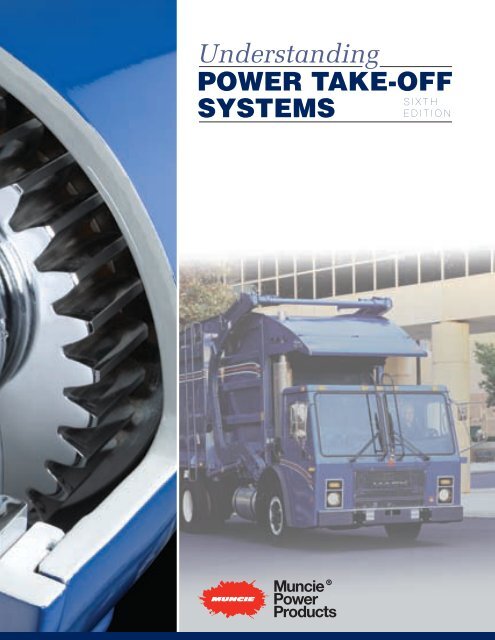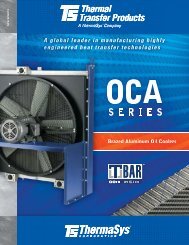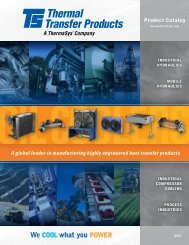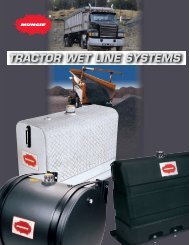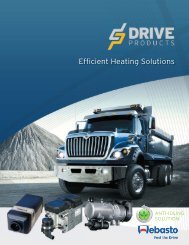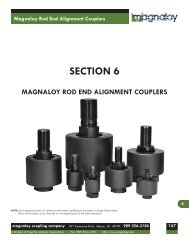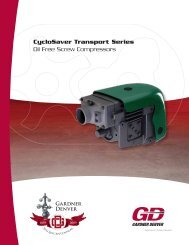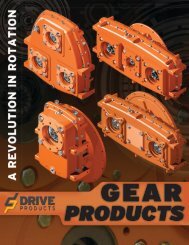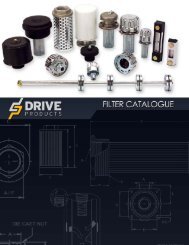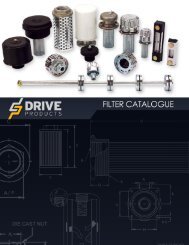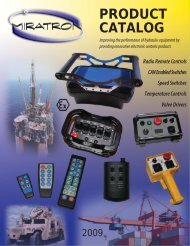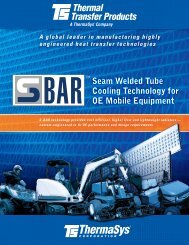Understanding Power Take-Off Systems - Muncie Power Products
Understanding Power Take-Off Systems - Muncie Power Products
Understanding Power Take-Off Systems - Muncie Power Products
- No tags were found...
Create successful ePaper yourself
Turn your PDF publications into a flip-book with our unique Google optimized e-Paper software.
Welcome to the sixth edition of <strong>Muncie</strong> <strong>Power</strong> <strong>Products</strong>’ UNDERSTANDINGPOWER TAKE-OFF SYSTEMS, the companion piece to our UNDERSTANDINGTRUCK MOUNTED HYDRAULIC SYSTEMS booklet. Together these containa body of valuable information on providing dependable auxiliary power ontoday’s work trucks.Many sources are called upon to produce an accurate and useful technical/trainingpublication. We thank the officers, employees, and customers of <strong>Muncie</strong> <strong>Power</strong><strong>Products</strong> for their many contributions. Special appreciation goes to Rick Wallace,<strong>Power</strong> <strong>Take</strong>-<strong>Off</strong> Product Manager, and <strong>Muncie</strong>’s engineering team in Tulsa, OKfor developing the quality PTO products that make <strong>Muncie</strong> <strong>Power</strong> <strong>Products</strong>, Inc.the leader in the industry.The illustrations, design, and graphics for this booklet, as well as all of <strong>Muncie</strong>’ssales and support literature, were contributed by Tony Jeroski and Mark Sherfick.We encourage anyone wishing to become more familiar with <strong>Muncie</strong> <strong>Power</strong><strong>Products</strong>, Inc. to visit our web site, www.munciepower.com, to learn more aboutour company and products. While there be sure to click on the link to ourM-POWER Customer Assistance Software for assistance in selecting the right<strong>Muncie</strong> PTO or hydraulic product for your application.David L. DouglassDirector of Trainingmuncie power products quality policy<strong>Muncie</strong> <strong>Power</strong> <strong>Products</strong> is dedicated to providing quality productsand services that will satisfy the needs and expectations of ourcustomers. We are committed to the continual improvement of ourproducts and processes to achieve our quality objectives, minimizecosts to our customers and realize a reasonable profit that willprovide a stable future for our employees.
Table of Contents<strong>Power</strong> <strong>Take</strong>-<strong>Off</strong> Defined………………………………………………………………… 3<strong>Power</strong> <strong>Take</strong>-<strong>Off</strong>s—A Brief History…………………………………………………… 4The Transmission Aperture…………………………………………………………… 6The <strong>Power</strong> <strong>Take</strong>-<strong>Off</strong> Input Gear … …………………………………………………… 7PTO Speed and Rotation… …………………………………………………………… 8PTO Selection… ………………………………………………………………………… 9The <strong>Muncie</strong> PTO Model Number… ……………………………………………………11PTO Torque and Horsepower Requirements…………………………………………13Adapter Gear Assemblies… ……………………………………………………………14Intermittent and Continuous Duty Cycles… …………………………………………15Types of <strong>Power</strong> <strong>Take</strong>-<strong>Off</strong>s… ……………………………………………………………17PTO Installation—Backlash… …………………………………………………………18
828CD10CS10FR838CS6CS20RG<strong>Power</strong> <strong>Take</strong>-<strong>Off</strong>s—A Brief HistoryThe earliest documented use we have of a power take-offis 1919 when a PTO was utilized to power an air compressorto inflate tires on a Cadillac automobile. By the 1930sPTO apertures were standard on truck transmissions andpower take-offs were being used to power winches, dumpbodies, and garbage trucks. Early PTO manufacturers includedGar Wood, Central Fiber <strong>Products</strong>, Spicer, TulsaWinch, Arrow, and Braden. These early manufacturersno longer exist as PTO manufacturers. Braden and TulsaWinch still exist as successful manufacturers of mechanicaland hydraulic winches. Eventually, Central Fiber andSpicer were acquired by Dana Corporation and their PTOproducts were combined into the Chelsea PTO line. ParkerHannifin Corporation now owns Chelsea.<strong>Muncie</strong> <strong>Power</strong> <strong>Products</strong> began in <strong>Muncie</strong>, Indiana in 1935as <strong>Muncie</strong> Parts Manufacturing Company, a distributor ofauto parts. By the late 1930s the company developed aninterest in power take-offs and by the 1960s began an expansionthat would make <strong>Muncie</strong> the largest PTO distributorin North America. The company name changed to <strong>Muncie</strong><strong>Power</strong> <strong>Products</strong>, Inc. in 1979. In 1981 <strong>Muncie</strong> <strong>Power</strong>,until then a distributor for Dana’s Chelsea line, entered intoa partnership with the Tulsa Winch Company and beganmanufacture of new PTO designs under the <strong>Muncie</strong> name.In 1986 <strong>Muncie</strong> purchased the Tulsa manufacturing facilityfrom its parent company. In 1999 <strong>Muncie</strong> joined the InterpumpGroup to become, along with two other InterpumpGroup PTO manufacturers, PZB and Hydrocar, a part ofthe worlds largest PTO power take-off manufacturing entity.The original power take-off was a single gear unit with agear that slid into mesh with a transmission gear, resultingin output shaft rotation. Single gear PTOs are stillmarketed today although their popularity is greatly diminished.Single gear PTOs are inexpensive and simple toservice. However, they lack many of the features, such asthe ability to accept direct-coupled hydraulic pumps thatare popular with today’s truck equipment installers. Singlegear PTOs also are limited by their torque and horsepowercapabilities. You will find them used primarily on singleaxle dump trucks and agricultural hoists.Multi-gear power take-offs, like the <strong>Muncie</strong> TG series,are the most common type of PTO because of their versatility.This type of PTO offers the user many features,such as direct pump mounting, shifter choice, and numerousspeed ratios and horsepower capabilities that make
.810"Typical fuller transmission1.085"The Transmission ApertureThe transmission’s PTO aperture may be of the six-bolt,eight-bolt, or ten-bolt type, referring to the number of fastenersused to attach the PTO to the transmission. Thesix and eight-bolt openings are S.A.E. standard sizes. Theten-bolt opening is exclusive to automatic transmissionsmanufactured by Allison and Caterpillar. The PTO aperturesof foreign transmissions, or U.S.–made transmissionswith metric bolts, are referred to as “non-standard”openings.S.A.E. Standards Pertaining to Transmission Mounted<strong>Power</strong> <strong>Take</strong>-<strong>Off</strong>sJ704 - Openings for Six and Eight-Bolt Truck TransmissionMounted <strong>Power</strong> <strong>Take</strong>-<strong>Off</strong>sJ722 - Clearance Envelopes for Six-Bolt, Eight-Bolt, and RearTruck Transmission Mounted <strong>Power</strong> <strong>Take</strong>-<strong>Off</strong>sJ2662 - Torque Ratings for <strong>Power</strong> <strong>Take</strong>-<strong>Off</strong> Mounting PadsJ2555 - Vehicle Idle Gear Rattle Evaluation ProcedureIn addition to size and bolt pattern there is also an S.A.E.standard gear mounting depth, referred to as the “pitchline to mounting face” (P.L.M.F.) dimension. This is 1.085inches for a standard six-bolt opening and .810 inch for astandard eight-bolt. <strong>Muncie</strong> <strong>Power</strong> <strong>Products</strong> designs PTOsto these mounting dimensions and allows for non-standardmounting depths by utilizing gear adapters to reach “deep”gears, or spacers (sometimes referred to as filler blocks)to adjust for “shallow” gears. Gear adapters are also frequentlyused to mount standard S.A.E. specification PTOsto imported transmissions with non-S.A.E. bolt patterns.The pitch line of a gear is a reference line which representsthe point on a gear tooth where load is transferred toa meshing gear during operation. While this is not a visuallyidentifiable point, it is typically at about the mid-pointof a gear tooth depending on the specific design profile ofthe tooth. The pitch line is an imaginary circle drawn byconnecting this point on each gear tooth and is used as areference point for establishing gear depth and for determining“pitch line velocity”, a linear representation of thegear’s speed used to calculate available horsepower. Thehigher the pitch line velocity, the more horsepower is availableto the PTO. Pitch Line Velocity is measured in feet perminute (FPM) rather than revolutions per minute (RPM).A small transmission with a low pitch line velocity mightbe suitable for a dump body or aerial bucket but may not
e able to provide enough power to run a large, multiplesection hydraulic pump or a pneumatic blower. For theseapplications a transmission with high pitch line velocity isrequired.DOWEL HOLES (2)(OPTIONAL)Pitch line velocity is a function of the internal gearing of thetransmission and the diameter of the transmission’s PTOdrive gear. Horsepower available at the PTO drive gearcan be calculated by the formula:HP = PlV × engine rPM × “k” ÷ 1000The “K” factor in the above equation represents the amountof horsepower per foot of PLV that the transmission canprovide: .038 hp/ft for six-bolt apertures, .085 hp/ft foreight-bolt, and .049 hp/ft for ten-bolt.1/2" 1/2"The standard location of the PTO drive gear in an S.A.E.six- or eight-bolt opening is ½ inch to the front or rear of thevertical centerline of the aperture. (On ten-bolt openings itis inch.) S.A.E. standard openings with standard gearlocations allow for power take-off models that are easilyinterchanged from one transmission to another. Non-standardopenings often require transmission-specifi c PTOs.THe POwer <strong>Take</strong>-<strong>Off</strong> inPuT Gear<strong>Power</strong> <strong>Take</strong>-<strong>Off</strong> input gears are designed to mesh with thetransmission’s PTO drive gear and transmit power to thePTO output shaft. <strong>Muncie</strong> works closely with truck transmissionmanufacturers to insure that the PTO gear matchesthe mounting depth, pitch, pressure angle, and helixangle of the transmission gear.There are two gear designs in use in truck transmissions:spur and helical. Spur gears are those which have teethcut parallel to their shaft bore. While more common theyare not as quiet as helical gears, which have teeth cut atan angle to their shaft bore. A negative consequence ofutilizing helical gears, particularly those with high helixangles, is the side thrust forces that can be generated byhigh torque transmissions. PTOs for transmissions withhigh helix angle gears frequently must utilize speciallycoated thrust washers in their input assemblies to toleratethese loads.Helical gears are further identifi ed as being either “lefthand” or “right hand” gears. The drawings demonstratehow to identify a gear as a left or right hand helical gear.A transmission gear with a left hand helix will require aright hand meshing PTO gear and vice versa.3/8"Spur GearHelical Gear7
The pitch of a gear is determined by the number of teethin a given area. The more teeth, the finer the pitch. A quickway to identify the approximate pitch of a gear is to measurethe number of teeth in a three inch area of its circumference.If you count six teeth it is a six pitch gear, ten teethand it is a ten pitch gear. Gears with high pitch counts willbe quieter and can carry more torque than low pitch gears.The most common gear design we see in truck transmissionsis the six pitch spur gear although, as gear manufacturingimproves, we are seeing manufacturers movingmore and more to helical gearing and finer gear pitches inan effort to provide more torque and quieter operation.PTORPMEngineRPM PTO %Engine RPM × PTO % = PTO RPMPTO RPM ÷ Engine RPM = PTO %PTO RPM ÷ PTO % = Engine RPMIn the above equations PTO % isexpressed as a decimal.ie: 85% = .85, 125% = 1.25, etc<strong>Power</strong> <strong>Take</strong>-<strong>Off</strong> Speed andRotation<strong>Power</strong> <strong>Take</strong>-<strong>Off</strong> output shaft speed is dependant upontruck engine speed, transmission gearing, pitch line velocity,and the internal gear ratio of the PTO. To simplify selection,<strong>Muncie</strong> calculates the transmission data and catalogsPTOs according to their output shaft speed relationship tothe truck engine. In <strong>Muncie</strong>’s PTO Quick Reference youwill see PTO speed expressed as a percentage of enginespeed. You can therefore determine the PTO speed in revolutionsper minute (RPM) by multiplying the engine speedby the PTO percentage.ENGINE SPEED × PTO % = PTO SHAFT SPEEDAll PTO driven components have an operating speedrange and the power take-off is selected which will properlymatch the desired engine operating speed to the requiredcomponent input speed. This can be determined by referringto the written specifications of the driven componentor consulting with your PTO supplier.PTO SHAFT SPEED ÷ ENGINE SPEED = PTO %In addition to speed it is also necessary to note the directionof rotation of the PTO output shaft.To avoid confusion this is stated in terms of the enginecrankshaft rotation. (All engine crankshafts turn in thesame rotation, clockwise when viewed from the front.)Thus, PTO shaft rotation is noted as being the same asengine (CRNK) or the opposite of engine (OPP). To avoidcomponent damage it is important to ensure that the PTO
otation matches the component requirement. In mostinstances the PTO rotation for a manual transmission isOPP and for an automatic it is CRNK.<strong>Power</strong> <strong>Take</strong>-<strong>Off</strong> SelectionProper PTO selection requires specific knowledge of thevehicle’s transmission and of the driven component. Withthis information, selection is a relatively simple process.What do you need to know to select a powertake-off?1..Transmission make and model number. This can befound on the manufacturer’s tag on the transmissionitself or, with a new vehicle, on the build sheet. Thelocal dealer may also be able to identify the transmissionthrough the Vehicle Identification Number(VIN).To which aperture the PTO will be mounted. This isgenerally dependant on the available space aroundthe PTO aperture, the PTO envelope space. Notethe presence of exhaust pipes, spring hangers, airtanks, etc.Notes on Replacingan existing PTO.• It is NOT uncommon for a PTO’sshift cover or output type to bechanged. (Make sure that the tagnumber matches the physical descriptionof the PTO.• If the PTO is being replaced dueto premature failure, review the applicationbefore replacing. Don’t repeatsomeone else’s mistake..The speed requirement of the driven componentand/or the desired PTO percentage.
4.5.6.7.The required direction of rotation of the PTO shaft.This will not present a problem if you are providingboth PTO and pump.The torque and horsepower requirement of the drivencomponent. This will often determine the PTO seriesto be used.If the driven component is to be a direct-coupled hydraulicpump, the mounting face and shaft dimensionsof the pump.The method by which the PTO will be engaged.Left Side of TransmissionRight Side of Transmission<strong>Muncie</strong> <strong>Power</strong>-<strong>Take</strong>-<strong>Off</strong> Assembly Arrangements10
The <strong>Muncie</strong> PTO Model Number<strong>Muncie</strong> <strong>Power</strong> <strong>Products</strong> uses a 13 character model number, dividedinto three segments, to describe the power take-off.The first segment describes the series and mounting pad.The second segment describes the gears in the PTO.The third segment describes the shifting method, assembly, outputshaft, and options.A sample model number is TG6S-M6505-A1BXTG– The first two characters of the model number– TG– identifiesthis PTO as a Triple Gear series. Other examples are Clutch Shift(CS), Constant Drive (CD), Super Heavy Duty (SH), and Reversible(RG or RL).6S– These characters identify the mounting pad as being a 6-bolt,S.A.E. standard. 8S is 8-bolt S.A.E. standard, and 6B and 8B designate6- and 8-bolt with metric fasteners.M65– In the second number segment, we find two sets of charactersthat identify the PTO input gear. The first character, a letter, identifiesthe transmission make; “M” for Mack, “S” for Spicer, “A” for Allison,etc. “U” (Universal) is used when a gear matches transmissions fromseveral manufacturers. The next two numbers designate the “gearpitch,” how widely spaced the gear teeth are.05– The last two numbers in this segment describe the internal gearratio of the PTO. In the sample PTO above, if one were to rotate theinput gear one complete revolution, the output shaft would rotate ½revolution, thus the internal ratio is 05. The output shaft of a 09 ratioPTO would rotate of a rotation and a 15 ratio PTO’s shaft wouldrotate 1.5 times with each rotation of the input gear.A– In the third model number segment, the first letter indicates thetype of shifting mechanism the PTO has: “A” for air, “C” for cable, “H”for hydraulic, etc.1– The next number, 1-2-3-4, is the PTO’s “assembly arrangement”;the assembly relationship of the housing, input gear, and outputshaft. 1 and 3 are the most common as they fit transmissions whosePTO drive gears are located to the front of the mounting aperture.B– The third character, “B” in the example, is a designator for theoutput shaft. There are round, keyed shafts for driveshaft connectionsand numerous combinations designed to direct-couple hydraulicpumps.X– The last character designates any special features or options. Inthe example, “X” indicates that there are no options.11
PTO TYPESingle Speed, Single GearSGSingle Speed, Double GearHC, PZ, SH, TGSingle Speed, Double Gear, Constant Drive CDClutch ShiftCS1 & 1 Reversible RG1 & 1 Reversible, Low Speed RL2 & 1 Reversible RXSAE 8 Bolt Double Gear, Single Speed 82SAE 8 Bolt 1 & 1 Reversible 83Ford AutomaticFA, FRAllison AutomaticGA, GMRear CountershaftRSMOUNTINGISO 4 Bolt Standard4SSAE 6 Bolt Standard Mount6SSAE 6 Bolt Deep Mount6DSAE 6 Bolt Non-Standard6NSAE 6 Bolt w/29TK3863 (for N56)6ASAE 6 Bolt Standard, Metric Stud Kit6BSAE 6 Bolt Deep Mount, Metric Stud Kit6CSAE 6 Bolt Standard, Less Drag Brake (CS6 only) 6GSAE/ISO 6 Bolt Standard, w/Dowel Holes6FSAE 8 Bolt Standard, Less Drag Brake (CS8 only) 8GSAE 8 Bolt Standard Mount8SSAE 8 Bolt Deep Mount8DSAE 8 Bolt Standard, Metric Stud Kit8BSAE 8 Bolt Deep Mount, Metric Stud Kit8CSAE 8 Bolt Extra Deep Mount8MAllison 10 Bolt, Heavy Duty 10 or 11Allison 10 Bolt 20 or 21Ford 4x2 62Ford 4x4 64TRANSMISSION GEARAisin 8.46P 20° PA Spur I84Allison 10.16P LH A10Allison 6.86P 20° PA Spur A68Caterpillar 9.55P 20º PA 19.73º LH C95Clark 5.7P 25° PA 37.7° RH C57Clark 6.10P 25° PA 18.68 LH C60Clark 6.10P 25° PA 32.28 RH C61Clark 7P 25° PA 30.78 RH C70Clark 7.61P 18.49 PA, 23.22 RH C76Ford 14.2P 15.9° PA 18° RH F14Fuller 10.1P 20° PA Spur F10Fuller 10.1P 21.5° PA Spur F11Fuller 6.1P 20.5° PA 29° RH F61Fuller 6.27P 22.5° PA Spur F62Fuller 6.35P 20° PA 22° RH F63Fuller 6.5P 20° PA 23° RH F65Fuller 6.65P 20° PA 21.5° RH F66Fuller 6.7P 25° PA 30.14° LH F67Fuller 6.0P 20° PA Spur F68Fuller 7.0P 23° PA 26° RH F70Fuller 7.5P 22° PA 15° RH F75Fuller 8.38P 18° PA 33.1° RH F84Fuller 8.5P 21° PA Spur F85G.M.C. 7P 20° PA 30° RH G70*G.M.C. 7.34P 20° PA 24° RH G73G.M.C. 7.93P 22.49° PA 30° RH G79G.M.C. 9.23P 20° PA 36° RH G92Getrag 8.46P 17.5° PA RH G85I.H.C. 6.54P 18.47 PA 23.45 RH H65Isuzu 8P 20° PA 15° RH I80Isuzu 8.46P 20° PA Spur I85Mack 6.48P 17.65° PA Spur M65Daimler/Mercedes 8.04P 17.5° PA 26.97° RHM80Daimler/Mercedes 8.38P 17.5° PA 24.97° RHM83Daimler/Mercedes 9.41P 18° PA 26.47° RHD94Mitsubishi 7.58P 20° PA 28.17° RH M76Mitsubishi 7.58P 20° PA 30° RH M78Mitsubishi 8.67P 22.5° PA 11.65° LH M89New Process 6P 20° PA 17.68 RH N60New Process 7P 20° PA 30.49 LH N70New Process 7.19P 16.88 PA 33.15 RH N71*New Process 7P 20° RH N72*New Process 8.11P 20° PA 33.5 RH N81New Venture 10.40P 20° PA 34.5° RH N10New Venture 7.94P 22.5° PA 30° LH N78New Venture 7.94P 22.5° PA 30° RH N79New Venture 7.99P 22.19° PA 29° RH N80Nissan 5.64P 20° PA Spur N56Nissan 9.27P 20° PA 25° LH N92Renault 6.77P 22.5° PA 23.87° RH R68Renault 8.47P 22.5° PA 28.46° RH R85Spicer 5.85P 20° PA Spur S58Spicer 6P 17.5° PA 26.17 RH S60Spicer 6P 17.5° PA 22.25° RH S61Spicer 6P 17.5° PA 26.06° LH S62Spicer 6.2P 20° PA 23.15° RH S63Spicer 6P or 6/8P 20° PA Spur Deep Reach S68Spicer 7P 17.5° PA 28.07 RH S70Spicer 7P 17.5° PA 18° RH S71Spicer 7P 20° PA 20° LH S72*Spicer 7P 22.5° PA 19° RH S73Spicer 8.10P 20° PA Spur S80Spicer 8.99P 20° PA Spur S8912CONSTRUCTION CHARTTG 6S – U68 07 – C 1 B X* Transmissions to which these gear pitches apply are obsolete. Contact <strong>Muncie</strong> for application information.SPECIAL FEATURESA — Reversed Shift CoverB — Special Lube Kit (CD10)C — Pressure Lube, Pulse Generator, EOS-111D — Pulse Generator with EOS-111E — U60 Input Gear w/Standard Mounting Gasket PackF — Special Idler Plate (G85)G — Special Lube ShaftH — High TorqueI — Dual Terminator Indicator SwitchJ — High Torque & Pressure LubeM — Special Idler PlateP — Pressure LubricationQ — Special Idler Plate & High TorqueR — PTO Pulse Generator (CS, SH), No Pressure LubeS — PTO Pulse Generator (CS, SH), Pressure LubeT — High Torque with PTO Pulse Generator (TG)U — Standard with PTO Pulse Generator (TG)V — U60 w/Standard Gasket & Special Idler Plate (TG)X — None3 –– Special Lube Kit (CS, CD)OUTPUT SHAFTA — 7/8" Round, 1/4" key (SG)A — SAE “D” 1-1/4" 14 Spline (82)B — 1-1/4" Round, 5/16" Key (TG, CS, SH, CD, FA, FR, RG, RL, RX)C — 1-1/2" 10 Spline (CD, CS, SH, 82, 83)D — SAE “B” Hydraulic Pump Flange (CD, CS, SH, TG, 82)E — SAE “C” Hydraulic Pump Flange (CS, SH, 82)F — SAE “A” Hydraulic Pump Flange (TG)G — Special Dana Mount (CS, SH, TG)H — 7/8" Round, 1/4" key, 5-3/4" long (SG)I — 1" Round (GB10)I — DIN 5462 (CS, SH, CD, TG, 82)J — 7/8" Round, 1/4" key, 3-1/4" long (SG)K — SAE “B” Hydraulic Pump Flange (CS, SH, TG)L — SAE “B” with Round Shaft (TG)M — SAE “A” (TG)N — 6 Bolt Round (TG), Special (FR64)P — SAE “B-B” 1" 15 Spline (CS, SH, TG, 82)Q — SAE “A” Hydraulic Pump Flange (CS, SH, TG, FR)R — SAE “A” Hydraulic Pump Flange (CD, TG)S — SAE “B” Hydraulic Pump Flange (CS, SH, TG)T — SAE “A” 3/4" 11 Spline (TG, FA, FR, GA, GM)T — SAE “B” Hydraulic Pump Flange (one end) (82)SAE “C” Hydraulic Pump Flange (opp. end) (82)U — SAE “C” Hydraulic Pump Flange (dual output) (82)V — SAE “B” Hydraulic Pump Flange (CS, SH, TG)W — SAE “A” 3/4" 11 Spline (FA, FR)X — 1-1/2" 10 Spline (CD, CS10, 82, 83)X — 1.3 - 10 Spline 21T (TG, CS20, CS6/8, SH)Y — SAE “C” Hydraulic Pump Flange (CD)Z — SAE “B” Hydraulic Pump Flange 1-1/4" 14 Spline (82, CD)2 — DIN 100 Companion Flange (TG, CS, SH, CD, 82, 83)6 –– SAE “B” 2-Bolt Special (CS)ASSEMBLY ARRANGEMENTS1, 2, 3, 4 (See pages 14-15)SHIFTER TYPESA — Manual Air (12 Volt Light)B — Special Electric/Air (TG-N56)C — CableD — Double Acting Air – 82 SeriesE — 12 Volt Elect/Air – All TGF — 24 Volt Elect/Air – All TGG — Spcl Elect/Air (TG-N56) (1995-98)H — 12 Volt Elect/Hyd – All CS-U60J — 24 Volt Elect/Hyd – All CS-U60K — Manual Air (24 Volt Light)L — LeverM — Constant Mesh – Non-ShiftableN — Spcl Elect/Air (TG-N56) (1999-01)P — Air Shift Less Activation KitQ — Double Acting Air – 82 SerR — Lever – Light Spring (RG)S — Lectra ShiftT — E-Hydra ShiftU — ObsoleteV — Double Acting Elect/AirX — NoneZ — Special Rocker Switch (FA)Z — Special Cable Shift (TG)4 — Special Air Shift (TG)5 — Special Elect/Air Shift (TG)6 — Special Lectra Shift (TG)SPEED RATIO (RANGE)03 — 0.25-0.34:1 09 — 0.85-0.94:1 15 — 1.45-1.54:104 — 0.35-0.44:1 10 — 0.95-1.04:1 16 — 1.55-1.64:105 — 0.45-0.54:1 11 — 1.05-1.14:1 17 — 1.65-1.74:106 — 0.55-0.64:1 12 — 1.15-1.24:1 18 — 1.75-1.84:107 — 0.65-0.74:1 13 — 1.25-1.34:1 19 — 1.85-1.94:108 — 0.75-0.84:1 14 — 1.35-1.44:1TRANSMISSION GEAR (cont.)Tremec 6.1P 25° PA 30.4° RH T61Tremec 8.1P 20° PA 29.47° LH T81Tremec 8.19P 20° PA 29.9° RH T82Universal 5 or 5/7P 20° Spur U57Universal 6P 20° Spur, Full Addendum U60Universal 6P 25° PA Spur U62Universal 6P 17.50° PA Spur U67Universal 6P or 6/8P 20° Spur U68Universal 6P or 6/8P 20° Spur, Full Dedendum X68Universal 8P 20° PA Spur U80Warner 8.08P 20° PA 30° RH W80Warner 9.60P 20° PA 21.6° LH W96Warner 9.60P 20° PA 21.6° RH W97Zed F 10.36P 20° PA 28° RH Z10Zed F 9.24P 23° PA 36.05° RH Z90Zed F 9.24P 23° PA 36.05° LH Z91Zed F 9.23P 20° PA 36° RH Z92Zed F 9.23P 20° PA 36° LH Z93Zed F 9.96P 20° PA 28.5° RH Z98Zed F 9.96P 20° PA 28.5° RH Z99None Less Input Gear Kit
PTO Torque and HorsepowerRequirementsBesides meeting the speed and rotational requirements ofthe driven component, the power take-off must also meetthe torque and horsepower requirements of the application.This information can usually be found in the owner’smanual of the equipment or by contacting the manufactureror distributor. There are also mathematical formulaethat can be used to calculate these requirements.The most common application for a power take-off is toprovide power to a hydraulic pump. If the flow and pressurerequirements of the hydraulic system are known, the horsepowerrequirement can be calculated by the formula:HP = GPM × PSI ÷ 1714Example: 25 GPM × 2000 PSI ÷ 1714 = 29 HPHorsepower— The amount of forcerequired to lift 550 pounds one foot inone second.The torque load placed on the PTO can then be determinedby the following formula:T = HP × 5252 ÷ RPMNote: In the above formula the RPM figure is the PTO shaftspeed, not the engine speed.So, the torque load on the PTO in the example, if the PTOshaft speed were 1200 RPM, would be:29 × 5252 ÷ 1200 = 127 lb.ft.In mechanical applications, where the PTO is supplyingpower directly to a driven component, the RPM and horsepowerrequirements must be obtained from an owner’smanual, specification sheet, or by contacting the manufactureror distributor of the component.All PTOs have torque and horsepower limitations andthese are shown on the application pages in the QuickReference Catalog. It is important to remember two thingsabout the published torque and horsepower ratings:1.Horsepower is directly proportional to PTO outputshaft speed and the published ratings are at 1000RPM. A PTO rated at 40 HP@ 1000 RPM, therefore,can deliver 80 HP at a shaft speed of 2000 RPM butonly 20 HP at a shaft speed of 500 RPM.Direction of RotationFulcrumdFTorque ArmForcecausingtorqueTorque— The magnitude of force multipliedby the distance from its point ofapplication to an axis of rotation..Torque is constant. The torque rating shown is themaximum at any shaft speed. The published torquerating is calculated to provide a minimum of 300 hourslife, at continuous service, at that torque level.13
Adapter Gear AssembliesAdapter gear assemblies are used to reach PTO drivegears in transmissions with non-standard mounting depths;to reverse PTO shaft rotation; or, in some instances, toangle a PTO to avoid a mounting obstruction. <strong>Muncie</strong>makes adapter gear assemblies to fit most transmissionsand in various body styles— solid body, vertical offset, andangular offset.Adapter gear used to reachnon-standard depth drive gear.Most adapter gears are made with the same diameter gearas the PTO input gear and do not affect the PTO speed.Some, which utilize a cluster gear, will affect speed. Referto the footnotes in the PTO Quick Reference catalog forspecific applications.Speed Increasing AdapterWhen utilizing an adapter, the following three things mustbe considered:Mesheswith PTOMeshes withTransmissionAdapter gears will always reverse the rotation of thePTO output shaft. In the PTO application catalog if anadapter is shown in the “ADAPTER” column, the rotationshown is with the adapter. If none is indicated in the“ADAPTER” column but one is shown in the “ADAPTERTO CHANGE ROTATION” area, the PTO rotation shownis without the adapter.Many adapter gears require reducing the PTO’s torqueand horsepower rating by 30% and many cannot beused in continuous duty applications. Always checkthe footnotes in the <strong>Muncie</strong> PTO Quick Reference catalogto determine if an adapter assembly can be used in yourapplication.Adapter gears often move the PTO outward, closer toframes, exhaust, etc. The exception is the angular offsetmodels. This can sometimes result in interference issues.Always check for proper clearance before specifyingan adapter.14
Intermittent and ContinuousDuty Cycles<strong>Power</strong> <strong>Take</strong>-<strong>Off</strong> torque and horsepower ratings are basedon an intermittent duty cycle, which is defined as five minutesor less at maximum horsepower or torque within a 15minute operating period. Operating more than five minutesat maximum horsepower or torque must be considered“continuous service”.PTOs used for continuous service must be considered tohave reduced horsepower and torque capacity. In mostcases the published rating must be reduced by 30%.Example: 200 lb.ft. minus 30% = 140 lb.ft.Example: 50 hp minus 30% = 35 hpFire pump applications are calculated differently and shouldbe de-rated by a factor of 20%.Any application with a PTO shaft speed above 2000 RPM,regardless of duration, should be considered continuousduty and the PTO rating reduced by 30%.COMMON POWER TAKE-OFF APPLICATIONSIntermittent DutyContinuous DutyDump TruckPneumatic BlowerRefuse Collectionliquid Transfer PumpAerial Bucketair CompressorWreckerVacuum PumpCraneGenerator DriveContinuous duty applications require de-rating of the PTOtorque and horsepower values by 30%.15
PTO TORQUE & HORSEPOWER RATINGSIntermittent service refers to an On-<strong>Off</strong> operation under load. If maximum HP and/or torque is used for extended periods oftime, (5 min. or more every 15 min.) this is considered “Continuous Service” and HP rating of PTO should be reduced bymultiplying intermittent value below by .70. Applications with PTO output shaft speeds above 2000 RPM, regardless of duration,are to be considered “Continuous” duty. MAX rated output shaft speed for all <strong>Muncie</strong> PTOs is 2500 RPM.Fire Pump applications are calculated within a different category listed on page 3 and are derated by multiplying intermittent value below by .80.Below is a chart showing the Intermittent and calculated continuous Torque rating of the PTOs included in this catalog. The Application pages may havelower ratings for these PTOs listed. The Application page rating may be adjusted to limit the PTO output to a rating which will not exceed the transmissionmanufacturers rating. The transmission manufacturer does not differentiate between Intermittent and Continuous; therefore, the Application pagerating is never to be exceeded. Refer to this page when there is a question of the rating (Intermittent or Continuous) for the PTO as it is manufactured.PTOSERIESSPEEDRATIOINTERMITTENTHP@1000 RPMINTERMITTENTTORQUE LBS.FT.CONTINUOUSTORQUE LBS.FT.INTERMITTENT[KW]@1000 RPMINTERMITTENTTORQUE [NM]CONTINUOUSTORQUE [NM]PTOSERIESSPEEDRATIOINTERMITTENTHP@1000 RPMINTERMITTENTTORQUE LBS.FT.CONTINUOUSTORQUE LBS.FT.INTERMITTENT[KW]@1000 RPMINTERMITTENTTORQUE [NM]CONTINUOUSTORQUE [NM]SG 10 25 130 91 [19] [176] [123]TG 04 54 285 200 [40] [386] [270]05 51 270 189 [38] [366] [256]06 47 245 172 [35] [332] [232]07 44 230 161 [33] [312] [218]08 44 230 161 [33] [312] [218]09 39 205 144 [29] [278] [195]12H 40 180 126 [30] [244] [171]13H 40 180 126 [30] [244] [171]15H 37 195 137 [28] [264] [185]18H 33 175 123 [25] [237] [166]CS6/8 03 57 300 210 [43] [407] [285]04 57 300 210 [43] [407] [285]05 57 300 210 [43] [407] [285]06 57 300 210 [43] [407] [285]07 57 300 210 [43] [407] [285]09 52 275 193 [39] [373] [261]12 52 275 193 [39] [373] [261]14 52 275 193 [39] [373] [261]SH6/8 05 76 400 280 [57] [542] [379]07 76 400 280 [57] [542] [379]09 71 375 263 [53] [508] [356]12 62 325 228 [46] [441] [309]13 62 325 228 [46] [441] [309]RG 13 26 140 N/A [19] [190] N/ARL 03 38 200 N/A [28] [271] N/A05 38 200 N/A [28] [271] N/A82 05 95 500 350 [71] [678] [475]08 85 450 315 [63] [610] [427]10 78 410 287 [58] [556] [389]12 71 375 263 [53] [508] [356]13 71 375 263 [53] [508] [356]15 67 350 245 [50] [475] [332]19 57 300 210 [43] [407] [285]83 05 95 500 N/A [71] [678] N/A06 95 500 N/A [71] [678] N/A12 71 375 N/A [53] [508] N/AFR62 06 29 150 105 [22] [203] [142]FR63 06 36 190 133 [27] [258] [181]FR64 06 36 190 133 [27] [258] [181]GA6B 05 30 158 111 [22] [214] [150]GM6B 05 30 158 111 [22] [214] [150]GB10 06 42 220 154 [31] [298] [209]07 36 190 133 [27] [258] [181]09 29 150 105 [22] [203] [142]CD10 05 76 400 280 [57] [542] [379]06 73 385 270 [54] [522] [365]07 68 360 252 [51] [488] [342]08 64 336 235 [48] [456] [319]10 59 310 217 [44] [420] [294]12 50 260 182 [37] [352] [246]15 43 225 158 [32] [305] [214]CD40 07 114 600 420 [85] [813] [569]12 93 490 343 [70] [664] [465]CS10 05 95 500 350 [71] [678] [475]/1106 91 480 336 [68] [651] [456]07 86 450 315 [64] [610] [427]08 80 420 294 [60] [569] [398]10 73 385 270 [54] [522] [365]CS20 06 62 325 228 [46] [440] [308]/2107 58 305 214 [43] [414] [290]08 56 295 207 [42] [400] [280]10 55 290 203 [41] [393] [275]12 48 250 175 [36] [338] [237]15 38 200 140 [28] [271] [190]CS41 07 114 600 420 [85] [813] [569]10 103 545 382 [76] [739] [517]12 93 490 343 [70] [664] [465]16The HC, PZ, and RS Series PTOs vary in their torque and horsepower ratings and are based on the transmission on which they are mounted. The torque rating of thesePTOs are shown on their respective application pages or you may contact <strong>Muncie</strong> <strong>Power</strong> <strong>Products</strong>, Inc. Product Engineering Dept. for this information.
Types of <strong>Power</strong> <strong>Take</strong>-<strong>Off</strong>sThere are two broad types, or families, of power take-offs:mechanical shift and clutch shift.Clutch type PTOMechanical PTOs are those which are engaged whengears slide into mesh with each other. Since a power takeoffis essentially a non-synchronized gearbox, it is importantthat the operator make certain that the transmissiongears stop turning before engaging the PTO. Engaging amechanical PTO with the transmission gears turning willresult in PTO and/or transmission damage.Mechanical power take-offs are commonly engaged bymeans of a lever, cable, or air pressure. This type is typicallyfound on manual transmissions. The <strong>Muncie</strong> TG Seriesis the most popular mechanical shift PTO. Other <strong>Muncie</strong>model series of this type are SH, SG, RG, RL, 82, and83.The most common PTO found on an automatic transmissionis the clutch shift type. Rather than engaging bymeans of a sliding gear, the clutch shift PTO utilizes clutchdisks and friction plates to engage. When hydraulic or airpressure is applied to an internal piston, the clutch disksand friction plates are forced together, engaging the PTO.Since there is no possibility of gear clash, this type of powertake-off can even be engaged with the vehicle in motion(as long as the truck engine speed remains under 1000RPM). <strong>Muncie</strong> clutch-type PTO series include the CS6/8,CS20/21, CS10/11, CS41, FR, GA, and GM models.Two other terms are used to describe power take-offs:“shiftable input” and “constant mesh”. A shiftable inputstyle PTO is one which has an input gear that slides inand out of mesh with the transmission gear to engage.<strong>Muncie</strong>’s SG series PTO would be an example. A constantmesh style is always in mesh with the transmission gearand engagement is done internally, within the PTO. The<strong>Muncie</strong> TG and CS series PTOs are examples of constantmesh power take-offs. Constant mesh PTOs are less likelyto negatively affect the transmission if operators are carelessin their PTO shifting practices.mechanical shift PTO17
<strong>Power</strong> <strong>Take</strong>-<strong>Off</strong> Installation—BacklashThe single most important aspect of PTO installation is theestablishment of the proper backlash, or spacing, betweenthe transmission and PTO gears. Backlash between matinggears serves several purposes: it allows for gear expansion,it maintains an oil film to reduce friction and noise,and it allows for easier PTO engagement.Dial Indicator<strong>Power</strong> take-offs that are mounted with insufficient backlash(too tight) will often produce a whining noise whilethose mounted with excessive backlash (too loose) willproduce a clattering noise. Other symptoms of insufficientbacklash are cracked mounting flanges, damaged gears,and, in some models, difficult shifting.For manual transmissions, establishing backlash is the responsibilityof the installer. Gaskets supplied with the PTOare added or removed to adjust the backlash to a rangeof .006” to .012”. New power take-offs are supplied withgaskets in two thicknesses, .010” and .020”. M u n c i erecommends the use of a dial indicator to ensure that thePTO backlash is properly established.Most power take-offs for automatic transmissions are suppliedwith a single “no guesswork” gasket and do not requirethe installer to adjust the fit although it is still a goodpractice to measure the backlash upon installation.SHAFT LIMITSSHAFT STL5/8” - 9T < 5,4903/4” - 11T < 10,1147/8” - 13T < 16,5001.0” - 15T < 25,6501-1/4” - 11T < 33,300<strong>Power</strong> <strong>Take</strong>-<strong>Off</strong> InstallationDirect Coupled Hydraulic PumpsDirect coupling a hydraulic pump to the PTO is a commonpractice as it eliminates the requirement for a driveline assemblywhich must be periodically serviced. When directcoupling a PTO and pump, it is necessary to specify a PTOoutput shaft and mounting flange that match those of thepump and, under certain conditions, provide a rear pumpbracket to support the weight of the pump.As previously stated, there are standard pump mountingconfigurations established by the Society of AutomotiveEngineers (S.A.E.) and designated by letter codes. Theseare based on the shaft diameter and number of splines, themounting bolt circle, and the pilot diameter of the mountingface. The “pilot” of the pump refers to the raised areaon the mounting face that serves to center the pump ontothe PTO flange. The most common pump mount, for truckmounted hydraulic systems, is the S.A.E. “B”, which typicallyincorporates a " diameter shaft with 13 splines.18
Correct PTO and pump shaft size are determined by selectingthat which will withstand the torque load up to thedesigned Shaft Torque Limit (STL). The STL is calculatedby multiplying the pump’s cubic displacement by the operatingpressure. The resulting figure is the STL. If the pumpis a tandem or triple section, the STL for the pump is thesum of those for each section. For maximum componentlife always choose the largest shaft available.Any time the combined weight of the pump and its fittingsand hoses exceeds 40 lbs. and/or the length of the pumpis greater than 14 inches, it is necessary for the installerto provide a bracket at the back of the pump to support itsweight. It is important that this bracket mount to two pointson the pump and two on the transmission case. This providesprotection from excessive vibration as well as upand down motion. Pump manufacturers often provide extendedbody studs for this purpose. This weight limitationis the same for both aluminum and cast iron bodied PTOs.Failure to install a properly designed support bracketwill result in damage to the PTO housing and possibletransmission failure if lubricant is lost.Another concern when direct coupling the PTO and hydraulicpump is a condition called “shaft fretting”. Shaftfretting causes rapid spline wear of the PTO and hydraulicpump shafts. The wear is evident where two metal surfacesare in contact with each other and micro-movementof the two surfaces against each other wears the surfaces.Typically, this leaves a brownish residue when the surfacesare left dry. Spline failure from fretting has increasedwith the advent of electronically controlled diesel engines.Based upon our own findings and industry reports, it is evidentthat failures due to fretting corrosion are caused byconditions (harmonic vibrations originating in the engine)that are beyond the control of the PTO and pump manufacturer.There are some measures, however, that can betaken to minimize the effects of these vibrations on thePTO and pump shafts. <strong>Muncie</strong> has taken the lead in thisarea by developing and promoting a PTO with a greaseablespline feature that allows for introduction of greaseinto the spline area without removing the pump. This isoffered as an option on several PTO models. <strong>Muncie</strong> alsoships all direct mount style PTOs with a long lasting, highquality lubricant pre-applied to the female shaft splines.Another common response to this problem is to specifypower take-offs and pumps with larger diameter shaftsand more splines. For example, the standard S.A.E. class“B” assembly, which incorporates a " diameter, 13 splineshaft, is replaced with an S.A.E. “B-B” assembly which,while having the same pilot and bolt circle dimensions, uti-Proper Bracket InstallationImproper Bracket InstallationShaft Fretting Damage19
lizes a 1” diameter, 15 spline shaft.Another shaft option is the DIN 5462, a European standardwhich features larger, flat splines and is available on manypumps. While none of these measures is a cure for splinefretting they can mitigate its effects and extend spline life.<strong>Power</strong> <strong>Take</strong>-<strong>Off</strong> InstallationShaft Driven EquipmentDIN FlangeSometimes it is not possible to direct couple a hydraulicpump, requiring the pump to be remote mounted and poweredfrom the power take-off by means of a driveshaft assembly.In other applications, the driven equipment is designedto be driven mechanically by the PTO rather than by hydraulics.These are “remote mount” applications. In eithercase, certain specification, installation, and maintenancerequirements must be met.SAE B FlangeSAE BB FlangeCritical Speeds for Solid ShiftingSHAFT DIAMETERLgth. 34" 7/8" 1.0" 1-1/4"24 4650 5425 6200 775036 2050 2400 2750 345048 1150 1350 1550 192560 750 850 1000 125072 500 600 675 850First and foremost, the correct type and series of driveshaftmust be selected. Solid shafting is not recommended butis frequently utilized in low speed/ low horsepower applicationsto save cost. Solid shafts cannot be balanced andcan vibrate, damaging PTO and pump shaft seals, causingleaks.Also, solid shafts, especially those longer than 48 inches,can easily have critical speeds below the PTO operatingRPM. The critical speed of a shaft is the maximum speedat which the shaft can rotate before it begins to bow in thecenter, like a jump rope. (Critical speed can be increasedby placing a hanger bearing in the center, effectively makingtwo shorter shafts out of one long one: ie, a 72” shaftwith a bearing placed in the center becomes two 36” shaftsfor the purpose of determining critical speed.)A far better choice is a balanced, tubular assembly designedto meet the speed, torque, and horsepower requirementsof the application. The Spicer 1000 series componentsare often referred to as a PTO series. For higherhorsepower applications the 1310 series is recommended.Consult <strong>Muncie</strong> or your local driveline professional for recommendationsif you are unsure of your requirements.The operating angle must also be considered in driveshaftapplications. The operating angle or “true joint angle” is acombined angle, calculated from the known vertical andhorizontal angles of the shaft. As shaft speed is increased,the acceptable TJA decreases.20
MaxSpeed(RPM)Max.TJA"A"3500º 5º3000º 5º2500º 7º2000º 8º1500º 11º1000º 12ºdrive line angLEsAPump* For speeds over 2500 RPM, contact <strong>Muncie</strong> for approval.For installations with angles in the top and side views, usethis formula to compute the true joint angle (TJA):Shaft failure due to Cyclic LoadingTJA = √A 2 + B 2Round, keyed PTO output shafts are susceptible to failureby high cyclic loading. Applications requiring round, keyedoutput shafts should be limited to the “severe duty” ratingshown in the chart below.Torque ratings for remote shaftsDuty CyclePTO shaft (Round, Keyed Intermittent continuous severeor External Spline) (lb.ft.) (lb.ft.) (lb.ft.)" with ¼" Key 130 90 351.0" with ¼" Key 130 90 601¼" with " Key 300 210 2001.3" 21T Spl. w/ Comp. Flange 300 210 2001½" 10T Spl. w/ Comp. Flange 600 420 390Whenever a driveshaft is utilized, it is important that it be“in phase” and that it incorporate a slip yoke at one end.A shaft is in phase when the ears of its two yokes arealigned as in the drawing. An out of phase shaft will vibrateand damage PTO and pump shaft seals. A functioningslip yoke will allow the shaft to adjust for flexing of thetruck chassis.The bearings and slip yoke of the driveshaft must be lubricatedas part of a regularly scheduled preventative maintenanceplan. A driveshaft failure often results in damageto other vehicle components in proximity to the shaft. Seriouspersonal injury is an ever-present possibility.APump21
Overspeed Protection DevicesOne advantage that clutch shifted PTOs offer over mechanicallyshifted models is the ability to protect the PTO,as well as other hydraulic system components, from damagecaused by excessive operating speeds. Overspeeddamage shows up as burnt PTO clutch packs, twisteddriveshafts, overheated hydraulic systems, failed hoses,and damaged hydraulic cylinders.SPD1000APTO SwitchOverspeed protection is accomplished by incorporating anoverspeed protection device in the system. <strong>Muncie</strong> <strong>Power</strong><strong>Products</strong> has been a leader in this area, first with the EOS-110 Electronic Overspeed Switch and, more recently, withthe introduction of the SPD-1000A System Protection Device.Both models are capable of sensing excessive engineRPM and, at a pre-programmed maximum speed,automatically disengaging the power take-off. The newestmodel, the SPD-1000A, also allows for inputs from othervehicle sensors to ensure that safe operating parametersare met for PTO operation. These might include neutralsafety switches, speedometer inputs, pressure switches,and open door sensors for example.It must be remembered that these devices can only beused with clutch type PTOs which can safely be engagedand disengaged without engaging the vehicle’s clutch.While not a requirement, they tend to be found on vehicleswith automatic transmissions.22
Body BuildersDodge Ram Truckswww.dodgebodybuilder.comFordwww.fleet.ford.com/truckbbas/Freightlinerhttp://www.accessfreightliner.com/newsinformation/m2bodybuilder/default.aspGMwww.gmupfitter.comInternational Truckhttps://evalue.internationaldelivers.com/service/bodybuilder/general/Isuzuwww.isuzutruckservice.com/bodybuilder.phpKenworthwww.kenworth.com/6500_arc_pre_mor.asp?file=1980TRANSMISSION MANUFACTURERSAllison Transmissionwww.allisontransmission.comCaterpillar Transmissionwww.cat.com/cda/layout?m=85740&x=7Eaton/Roadrangerhttp://www.roadranger.com/Roadranger/productssolutions/transmissions/index.htmMercedes Transmissions (Freightliner)http://www.freightlinertrucks.com/trucks/featured-components/transmissions.aspxTTC (Spicer and Tremec)http://www.ttcautomotive.com/English/home/home.aspZF/Meritor Transmissionshttp://www.meritorhvs.com/Product.aspx?product_id=26Mack Truckshttp://smrpprod.macktrucks.com/spubs/internet/bbtoc.htmNissan (UD Trucks)www.udtrucks.com/bbb.htmPeterbilt Motorswww.peterbilt.com/Sterlinghttp://216.45.19.226/vocrefguide/Toyotawww.toyotaupfitter.comVolvo Truckshttp://www.volvo.com/trucks/na/en-us/products/bodybuilder/23
formulas for calculator useto solve for:24calculator entry:PTO OUTPUT SPEED… ……………………………… PTO RPM = ENGINE RPM x PTO%REQUIRED ENGINE SPEED… ……………………… ENGINE RPM = DESIRED PTO RPM ÷ PTO%HORSEPOWER… ……………………………………… HP = T X RPM ÷ 5252TORQUE… ……………………………………………… T = HP X 5252 ÷ RPMAREA OF A CIRCLE… ………………………………… A = πr 2 or A = d 2 × .7854VOLUME OF A CYLINDER… ………………………… V = πr 2 × Li ÷ 231or… …………………………………………………… d 2 × .7854 × Li ÷ 231FORCE OF A CYLINDER… …………………………… F = A × PSICYLINDER EXTENSION (inches/second)… ………… EXT. RATE = GPM × 4.9 ÷ d 2CYLINDER EXTENSION (time to extend)… ………… EXT. TIME = CYL. VOLUME × .26 ÷ GPMVOLUME OF A RESERVOIR (rectangular)…………… VOL = Li × Wi × Di ÷ 231VOLUME OF A RESERVOIR (round)… ……………… VOL = πr 2 × Li ÷ 231or… …………………………………………………… d 2 × .7854 × Li ÷ 231PUMP OUTPUT HORSEPOWER……………………… HP = GPM × PSI ÷ 1714PUMP INPUT HORSEPOWER………………………… HP = GPM × PSI ÷ 1714 ÷ EPUMP INPUT TORQUE (ft.lb.)… ……………………… T = CID × PSI ÷ 24πPUMP OUTPUT FLOW… ……………………………… GPM = CIR × RPM ÷ 231 × EPUMP INPUT SPEED…………………………………… RPM = GPM × 231 ÷ CIR ÷ EDISPLACEMENT OF PUMP… ………………………… CIR = GPM × 231 ÷ RPM ÷ Econversion chartFrom English Units (US) to Système International (METRIC)Notes:T = Torque (ft. lb.)A = Area of circle (sq.in.)F = Forced = diameterr = radiusπ = 3.1416 (pi)Li = Length (inches)Wi = Width (inches)Di = Depth (inches)VOL = VolumeE = EfficiencyCIR = Cubic Inches/RevolutionV = Velocity1 GAL = 231 cu inFLOW IN GPM USING PTO… ………………………… GPM = ENGINE RPM × PTO% × CIR ÷ 231 × EVELOCITY OF OIL… …………………………………… V = GPM × .3208 ÷ APRESSURE DROP THRU AN ORIFICE……………… ∆P = .025 × GPM2 ÷ d 5HEAT RISE IN DEGREES F… ………………………… ∆Fº = HP × 746 × Inefficiency × Minutes ÷ Gallons in system ÷ 60note: The following hydraulic motor formulas are calculated ininch pounds (in.lb.) rather than foot pounds. To convert to ft.lb. divide by 12.MOTOR OUTPUT TORQUE:CONTINUOUS…………………………………………… Tc = GPM × PSI × 36.77 ÷ RPMor… …………………………………………………… Tc = CID × PSI ÷ 2 πor… …………………………………………………… Tc = HP × 63025 ÷ RPMSTARTING……………………………………………… Ts = Tc × 1.3ACCELERATING………………………………………… Ta = Tc × 1.1MOTOR WORKING PRESSURE……………………… T × 2 π ÷ CIR ÷ EMOTOR RPM… ………………………………………… RPM = GPM × 231 ÷ CIRFrom to multiply by or divide bycu.in. (in 3 )……………… cC (cm 3 )… ……………………………16.39… …………………… 0.06102cu.in. (in 3 )……………… liters……………………………… 0.01639… ………………61.02Pounds Feet… ……… Newton Meters (Nm)…………… 1.356… ………………… 0.7376gallons (u.s.)………… liters……………………………… 3.785… ………………… 0.2642Horsepower… ……… btu… …………………………… 2545.0… …………………… 0.00093Horsepower… ……… watts…………………………… 745.7… …………………… 0.001341Horsepower… ……… kw… ………………………………… 0.7457…………………… 1.341psi (Pounds/in 2 )… ……… bar …………………………………… 0.06895… ………………14.5psi (Pounds/in 2 )… ……… KiloPascal (KPa)… ………… 6895.0… …………………… 0.000145pound…………………… kilogram…………………………… 0.4536…………………… 2.2046Inch… …………………… millimeter (MM)… ………………25.4… …………………… 0.03937Mile… …………………… kilometer (KM)…………………… 1.6093…………………… 0.6214call muncie power products at 1-800-367-7867
Corporate Headquarters • <strong>Muncie</strong>, IndianaGLOBAL MOBILE POWER<strong>Muncie</strong> <strong>Power</strong> <strong>Products</strong>, Inc., part ofthe global Interpump Hydraulics Group,manufactures a full line of power take-offsand hydraulic components to bothSAE and DIN specifications.Manufacturing Division • Tulsa, Oklahoma123DID YOU KNOW?A knowledgeable sales force is more confident,better prepared, and more productive.An educated counterman can service morecustomers, faster, and recognize those extra,hidden sales opportunities.A trained service technician spots problemsquicker and fixes them faster.Combine all three of these and what do you have?MORE OPPORTUNITIES • GREATER ACCURACY • HIGHER PROFITSA <strong>Muncie</strong> <strong>Power</strong> <strong>Products</strong> training classcan do all of this for your business. At<strong>Muncie</strong>’s training facilities in <strong>Muncie</strong>,Indiana and Tulsa, Oklahoma, or at yourown site, a qualified <strong>Muncie</strong> trainer canmake your personnel more knowledgeable,more accurate, and more productive.For details on any of <strong>Muncie</strong>’s class offeringstalk to your <strong>Muncie</strong> <strong>Power</strong> <strong>Products</strong>Zone Sales Manager or call our Trainingdepartment at 1-800-FOR-PTOS.Additional training literature available upon request:<strong>Understanding</strong> Truck Mounted Hydraulic <strong>Systems</strong> (TR-G93-01)<strong>Muncie</strong> Training Overview Brochure (TR05-01)<strong>Muncie</strong><strong>Power</strong><strong>Products</strong>TR-G94-01 (Rev. 7-08) Printed in the U.S.A.© <strong>Muncie</strong> <strong>Power</strong> <strong>Products</strong>, Inc. 2008<strong>Muncie</strong> <strong>Power</strong> <strong>Products</strong>, Inc. Member of the Interpump Hydraulics GroupGeneral <strong>Off</strong>ices and Distribution Center • P.O. Box 548 • <strong>Muncie</strong>, IN 47308-0548(765) 284-7721 • FAX (765) 284-6991 • E-mail info@munciepower.comWeb site http://www.munciepower.comDrive <strong>Products</strong>, Exclusive Agents for Canada, ISO Certified by an Accredited Registrar


